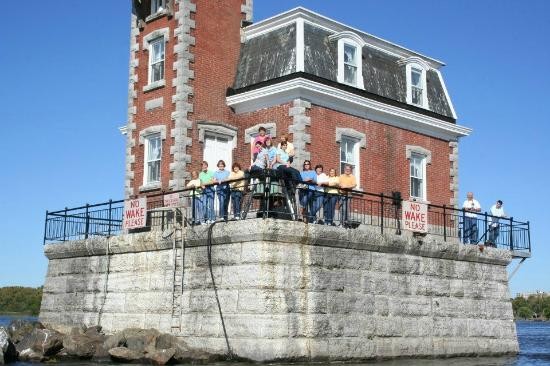Hudson-Athens Lighthouse
Introduction
Text-to-speech Audio
Midway between the small towns of Hudson and Athens is the picturesque Hudson-Athens Lighthouse. Construction of the lighthouse began in 1873 on a mudflat in the river where ships commonly found themselves stranded. The first beacon was lit in 1874 by Henry Best, the lighthouse’s first keeper. In the many years since then, the lighthouse narrowly escaped demolition but was saved by the efforts of preservationists. Time and the elements have caused the lighthouse's foundation to sink a bit into the riverbed and there are currently efforts underway to shore up its base. The lighthouse is listed on the National Register of Historic Places and is open to the public for occasional tours.
Images
The Hudson-Athens Lighthouse

A close-up view of the lighthouse

Backstory and Context
Text-to-speech Audio
In the first few years after the American Revolution, there were concerns in some quarters that Great Britain might try to reclaim its former colonies. Consequently, whalers in Martha's Vineyard and Nantucket moved their operations farther inland, settling along the west bank of the Hudson River. They named their settlement, which was chartered in 1798, Hudson. Directly across the river, the town of Athens was founded in 1805. In time, both towns became important ports along the Hudson River.
At that time, the river was an important trade route. But because of mud flats in the area between Athens and Hudson, ships routinely became stuck. The flats, known as Middle Ground Flats, became enough of a hindrance that locals began pushing for the construction of a lighthouse on the site. It was only in 1872, however, that Congress approved $35,000 for the project. Work began on the lighthouse the following year.
To build the lighthouse's foundation, 200 wooden pilings were sunk 50 feet deep in the mudflats. The pilings were topped with a granite pier, upon which the keeper's dwelling would be built. This was a common construction method in the nineteenth century. To protect the north end of the granite base, it was designed like the bow of a ship, a technique that would minimize the effects of ice floes, which were frequent. The house itself looks nothing like most lighthouses. The two-story brick and granite structure was built in the Second Empire style and appears to sit on top of the massive granite blocks which conceal the wooden pilings.
The lighthouse began operations in November of 1874, with Henry Best serving as its first keeper. Almost exactly 75 years later, the lighthouse became automated. Despite the precautions taken during the lighthouse's construction, time and the elements took a toll on the building's foundation and by the late twentieth century, there was talk of demoilishing the structure, one of the only Hudson River lighthouses still standing. The building was saved thanks to the efforts of preservationists, and there are currently efforts underway to shore up the foundation, which has sunk deeper into the mudflats over the years. The lighthouse was designated as one of the "Seven to Save" for 2020-21 by the Preservation League of New York.
Sources
The Hudson-Athens Lighthouse Preservation Society Historical Background, Hudson Athens Lighthouse Preservation Society . Accessed August 4th 2021. http://www.hudsonathenslighthouse.org/.
Lekocevic, Melanie. A Beacon of Light at Risk of Sinking, Hudson Valley 360. May 4th 2021. Accessed August 5th 2021. https://www.hudsonvalley360.com/news/greenecounty/a-beacon-of-light-at-risk-of-sinking/article_65cfe841-9c3b-50dd-85ca-7aaf91ae9cdf.html.
Hudson (Hudson-Athens) Lighthouse , Lighthouse Friends . Accessed August 5th 2021. https://www.lighthousefriends.com/light.asp?ID=677.
